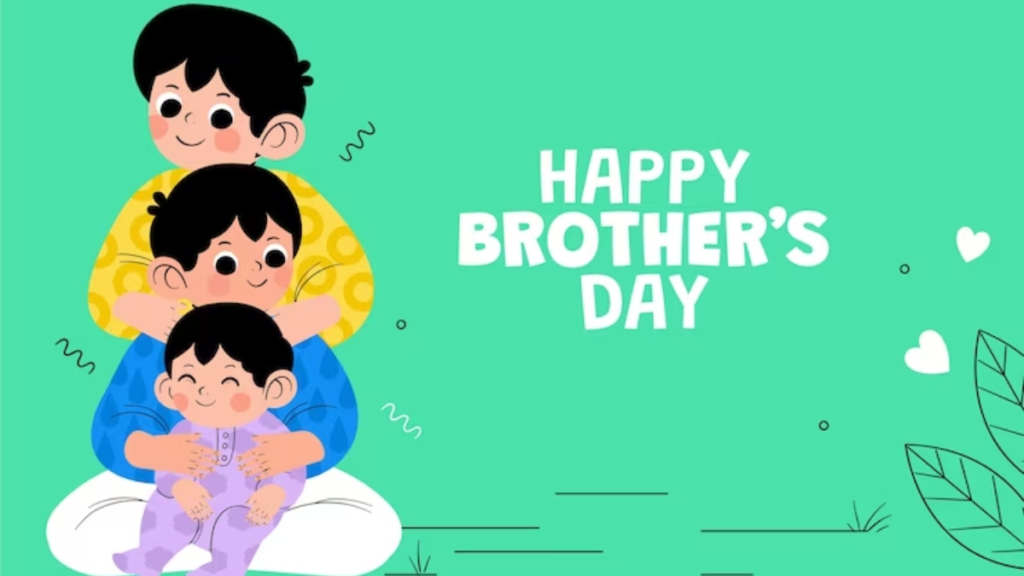
Table of Contents
- Introduction: Celebrating the Bond Beyond Borders
- The Origins of Brother’s Day
- When Is Brother’s Day Celebrated?
- United States: Where It All Began
- India: Raksha Bandhan and Bhai Dooj – A Sacred Thread
- Germany: Brothers by Heart, Not Just Blood
- Nepal: Bhai Tika – A Festival of Eternal Bond
- Latin America: Día del Hermano
- Philippines: Celebrating Brotherhood Through Bayanihan
- Brotherhood in Global Culture and Literature
- Modern Celebrations: Social Media, Gifts, and More
- Conclusion: A Bond That Deserves to Be Celebrated
1. Introduction: Celebrating the Bond Beyond Borders
There’s something timeless and universally understood about the relationship between brothers. Whether bonded by blood or choice, this relationship is layered—marked by playful rivalry, unwavering support, fierce loyalty, and moments of deep emotional connection. Around the globe, this special connection has been given a day, or in some cultures, an entire festival to honor it. Welcome to the global story of Brother’s Day—where, how, and why it’s celebrated.
2. The Origins of Brother’s Day
Though familial celebrations are ancient, Brother’s Day as a modern commemoration has relatively recent roots. In the United States, it is believed to have been popularized by C. Daniel Rhodes in Alabama around the early 2000s. While not an official public holiday, the idea of honoring brothers resonated and soon started to spread both online and through personal traditions.
3. When Is Brother’s Day Celebrated?
The date varies depending on the culture:
- May 24 – Commonly recognized as Brother’s Day in the U.S. and several other countries.
- August (Full Moon Day) – Celebrated as Raksha Bandhan in India.
- Two days after Diwali – Bhai Dooj in India and Nepal.
- October–November – Bhai Tika in Nepal.
- September 5 – Día del Hermano in parts of Latin America.
Some countries don’t have a specific “Brother’s Day” but incorporate the spirit into broader family-oriented festivals.
4. United States: Where It All Began
In the United States, May 24th is set aside to appreciate brothers—both biological and chosen. It’s not a nationwide public holiday, but families and friends use the occasion to send cards, exchange gifts, or share heartfelt messages. It’s often a day of reflection, nostalgia, and gratitude.
5. India: Raksha Bandhan and Bhai Dooj – A Sacred Thread
In India, the brother-sister bond is celebrated through Raksha Bandhan and Bhai Dooj, two vibrant festivals steeped in tradition.
- Raksha Bandhan: Sisters tie a “rakhi” (sacred thread) on their brothers’ wrists, praying for their protection. In return, brothers vow to protect their sisters and often give them gifts.
- Bhai Dooj: Celebrated shortly after Diwali, this festival involves rituals, sweets, and a ceremonial tilak (mark) on the brother’s forehead, symbolizing blessings and love.
These festivals are more than just tradition—they’re deeply emotional events celebrated across regions, languages, and religions.
6. Germany: Brothers by Heart, Not Just Blood
Germany may not have an official Brother’s Day, but it has a strong culture of friendship and camaraderie. Celebrations like Männertag or Herrentag (Men’s Day), held on Ascension Day, often double as a celebration of male companionship—including brothers. It’s a day of hiking, barbecues, and bonding that embodies brotherhood beyond biological ties.
7. Nepal: Bhai Tika – A Festival of Eternal Bond
In Nepal, Bhai Tika is celebrated during the Tihar festival. Sisters perform a five-color tika ceremony, offer garlands made of marigold, and present delicacies to their brothers. The brothers, in turn, give gifts and vow to protect their sisters. The ritual is deeply symbolic, representing a wish for the brother’s long life and prosperity.
8. Latin America: Día del Hermano
Several Latin American countries observe Día del Hermano, or Brother’s Day, often on September 5, though the celebration isn’t as widely recognized. It’s a growing movement influenced by global trends, where siblings share affection and express appreciation—mostly through social media, small gatherings, or heartfelt notes.
9. Philippines: Celebrating Brotherhood Through Bayanihan
In the Philippines, while there isn’t a specific day marked as Brother’s Day, the cultural concept of bayanihan (communal unity and cooperation) reflects the spirit of brotherhood. Whether it’s among family, friends, or neighbors, Filipinos value loyalty, respect, and helping one another—principles at the core of brotherhood.
10. Brotherhood in Global Culture and Literature
From Shakespeare’s “Hamlet” to The Brothers Karamazov by Dostoevsky, the theme of brotherhood runs deep in literature. Modern cinema—like “The Pursuit of Happyness,” “Legends of the Fall,” or “The Lion King”—often weaves powerful narratives around brothers. This archetype reflects our collective understanding that brothers—whether united by blood or chosen by life—shape who we are.
11. Modern Celebrations: Social Media, Gifts, and More
In the digital age, Brother’s Day has found new life on social media. Hashtags trend, photo montages get shared, and siblings across continents reconnect. Common ways people celebrate include:
- Posting throwback photos
- Sending personalized gifts
- Sharing heartfelt letters or voice notes
- Hosting sibling get-togethers
The simplicity or grandeur of the celebration doesn’t matter—what counts is the sentiment.
12. Conclusion: A Bond That Deserves to Be Celebrated
No matter where you are in the world, the bond between brothers is universal—rooted in trust, memories, laughter, and sometimes a few heated debates. Brother’s Day may look different depending on geography and culture, but its heart remains the same: a celebration of a relationship that stands the test of time.
So whether you tie a rakhi, send a card, or simply say “thanks for being there,” remember—every brother deserves to be celebrated.

